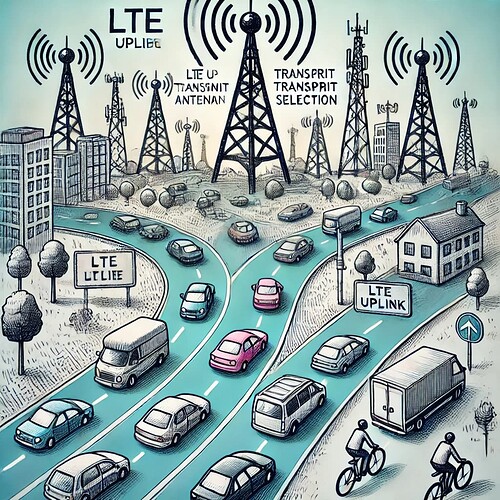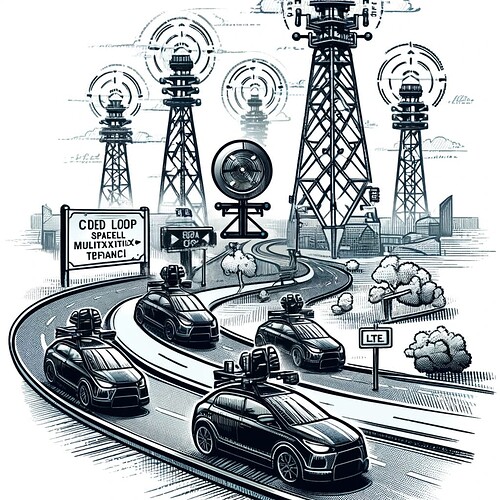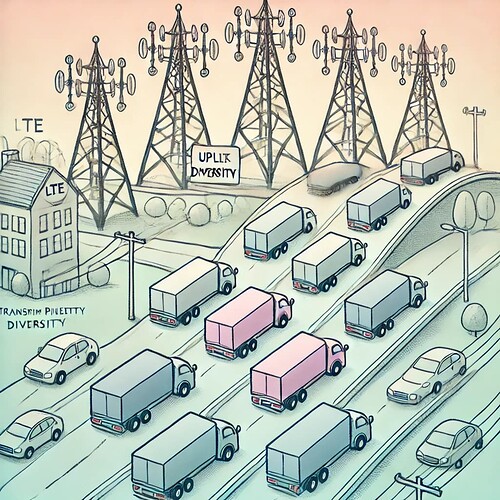This topic presents in a very simplified way all the main concepts that should be understood by those who know LTE.
LTE Uplink Multiple Antenna Technologies
The LTE Uplink Multiple Antenna Technologies help improve the speed, reliability, and efficiency of sending data from your device to the network by using multiple antennas in smart and flexible
![]() In the LTE city, these different antenna technologies help your device send its data to the network by choosing the best routes, driving styles, and using multiple cars to make sure the data always gets there on time!
In the LTE city, these different antenna technologies help your device send its data to the network by choosing the best routes, driving styles, and using multiple cars to make sure the data always gets there on time!
Skip to: Roadmap to LTE
- Antenna Ports
- Transmission Modes
- Transmit Antenna Selection
- Multi-User MIMO
- Closed Loop Spatial Multiplexing
- Transmit Diversity
Antenna Ports
In LTE Uplink, each antenna port allows your device to send its data through a different path to the network. More antenna ports mean more paths for your data, improving the connection’s speed and reliability.
![]() In our LTE city, think of antenna ports as different streets your car (data) can take to reach the network. The more streets (antenna ports) available, the more options your car has to travel, helping to reduce traffic and ensure your data reaches its destination smoothly. Alternatively, you can imagine antenna ports as messenger pigeons in the LTE city. Each pigeon carries a message from your house (device) to the network tower. More pigeons mean more messages can be delivered quickly and without confusion. Also, for LTE uplink, antenna ports can be compared to individual speakers in a surround sound system. Each port acts as a channel that transmits data from your device to the network. Using multiple ports helps improve signal quality, reduces interference, and makes your connection clearer and more reliable.
In our LTE city, think of antenna ports as different streets your car (data) can take to reach the network. The more streets (antenna ports) available, the more options your car has to travel, helping to reduce traffic and ensure your data reaches its destination smoothly. Alternatively, you can imagine antenna ports as messenger pigeons in the LTE city. Each pigeon carries a message from your house (device) to the network tower. More pigeons mean more messages can be delivered quickly and without confusion. Also, for LTE uplink, antenna ports can be compared to individual speakers in a surround sound system. Each port acts as a channel that transmits data from your device to the network. Using multiple ports helps improve signal quality, reduces interference, and makes your connection clearer and more reliable.
- Search Forum
 LTE Uplink Antenna Ports
LTE Uplink Antenna Ports 
Transmission Modes
Transmission modes are like different ways your data can be sent through the antennas. In LTE Uplink, there are several modes, each designed for different conditions. Some modes are best for speed, while others focus on reliability.
![]() Transmission modes in LTE are like choosing different driving methods to navigate through a city. Sometimes you take a shortcut to save time, while other times you drive slowly to avoid obstacles. These driving styles (modes) ensure your data reaches the network in the most efficient way based on the situation. You can also think of transmission modes as different vehicles - bikes, cars, or buses - each suited for different kinds of trips. Your device selects the best vehicle depending on how busy the roads are, ensuring smooth and timely data delivery. It’s like picking the right route for your car based on traffic or using the right gear for road conditions, adjusting to changes for efficient transmission.
Transmission modes in LTE are like choosing different driving methods to navigate through a city. Sometimes you take a shortcut to save time, while other times you drive slowly to avoid obstacles. These driving styles (modes) ensure your data reaches the network in the most efficient way based on the situation. You can also think of transmission modes as different vehicles - bikes, cars, or buses - each suited for different kinds of trips. Your device selects the best vehicle depending on how busy the roads are, ensuring smooth and timely data delivery. It’s like picking the right route for your car based on traffic or using the right gear for road conditions, adjusting to changes for efficient transmission.
- Search Forum
 LTE Uplink Transmission Modes
LTE Uplink Transmission Modes 
Transmit Antenna Selection
In LTE Uplink, your device can choose which antenna to use to send the data, depending on which one provides the best signal (clearest path) to the network. It can select the best antenna to use for sending data, ensuring the strongest and most reliable connection.
![]() It’s like having multiple roads to choose from, and your car picks the best one for a smooth trip, avoiding traffic jams and finding the fastest route. Alternatively, you can think of it as choosing the right courier for a delivery - sometimes a bike messenger is quicker in traffic, while other times a van is better for heavy packages. In the same way, your device selects the optimal antenna to send your data in the fastest and most reliable way possible.
It’s like having multiple roads to choose from, and your car picks the best one for a smooth trip, avoiding traffic jams and finding the fastest route. Alternatively, you can think of it as choosing the right courier for a delivery - sometimes a bike messenger is quicker in traffic, while other times a van is better for heavy packages. In the same way, your device selects the optimal antenna to send your data in the fastest and most reliable way possible.
- Search Forum
 LTE Uplink Transmit Antenna Selection
LTE Uplink Transmit Antenna Selection 
Multi-User MIMO
In LTE Uplink, multiple users can send their data at the same time, using different antennas, without interfering with each other. This improves overall network efficiency. Multi-User MIMO (Multiple Input Multiple Output) is a technique that allows multiple devices to send and receive data simultaneously over the same frequencies, increasing the capacity and efficiency of the network.
![]() Multi-User MIMO is like driving on a multi-lane highway where each car has its own special lane, so no one gets stuck in traffic - cars using dedicated lanes to avoid slowdowns. It’s like a super-wide highway where many vehicles can travel side by side, maintaining speed and efficiency. Multi-User MIMO ensures that several devices can send and receive data at the same time, just like multiple cars can use different lanes to keep traffic flowing smoothly.
Multi-User MIMO is like driving on a multi-lane highway where each car has its own special lane, so no one gets stuck in traffic - cars using dedicated lanes to avoid slowdowns. It’s like a super-wide highway where many vehicles can travel side by side, maintaining speed and efficiency. Multi-User MIMO ensures that several devices can send and receive data at the same time, just like multiple cars can use different lanes to keep traffic flowing smoothly.
- Search Forum
 LTE Uplink Multi-User MIMO
LTE Uplink Multi-User MIMO 
Closed Loop Spatial Multiplexing
Closed Loop Spatial Multiplexing allows your device to get feedback from the network about the best way to send data through multiple antennas. It adjusts the transmission in real-time to ensure data arrives faster and more reliably. It is a sophisticated technique where your device and the network constantly communicate to optimize data transmission.
![]() This is like having a GPS that gives your car real-time updates on the best route to take while driving. In closed-loop spatial multiplexing, your device receives feedback from the network, allowing it to adjust its path to ensure data is delivered quickly and without loss. It’s similar to having a personal GPS that constantly updates to avoid traffic, helping your device and the network collaborate for efficient data transmission. It’s like having a personal coach guiding you step-by-step to improve performance, ensuring that data always follows the most efficient route.
This is like having a GPS that gives your car real-time updates on the best route to take while driving. In closed-loop spatial multiplexing, your device receives feedback from the network, allowing it to adjust its path to ensure data is delivered quickly and without loss. It’s similar to having a personal GPS that constantly updates to avoid traffic, helping your device and the network collaborate for efficient data transmission. It’s like having a personal coach guiding you step-by-step to improve performance, ensuring that data always follows the most efficient route.
- Search Forum
 LTE Uplink Closed Loop Spatial Multiplexing
LTE Uplink Closed Loop Spatial Multiplexing 
Transmit Diversity
In LTE Uplink, your device sends the data through multiple antennas, ensuring that if one signal path is weak, the other can still deliver the data successfully. It is a method where the same data is sent from multiple antennas to ensure that it reaches its destination even if one path encounters obstacles.
![]() Transmit diversity is like sending several identical cars with the same package along different roads. If one car gets stuck in traffic, the other cars can still deliver the package. This way, your data always makes it to the network, even if one of the paths isn’t working perfectly. Transmit diversity is like sending multiple messengers on different paths to make sure your important letter arrives safely. Even if one path is blocked, another messenger will get through, ensuring your data reaches its destination no matter what. Transmit diversity is like sending the same package along different routes to ensure it gets there, even if one path has problems. It’s also like sending several messengers on different routes to deliver the same message, ensuring it arrives safely no matter what.
Transmit diversity is like sending several identical cars with the same package along different roads. If one car gets stuck in traffic, the other cars can still deliver the package. This way, your data always makes it to the network, even if one of the paths isn’t working perfectly. Transmit diversity is like sending multiple messengers on different paths to make sure your important letter arrives safely. Even if one path is blocked, another messenger will get through, ensuring your data reaches its destination no matter what. Transmit diversity is like sending the same package along different routes to ensure it gets there, even if one path has problems. It’s also like sending several messengers on different routes to deliver the same message, ensuring it arrives safely no matter what.
- Search Forum
 LTE Uplink Transmit Diversity
LTE Uplink Transmit Diversity 
That’s it. ![]()
-
Continue reading: Roadmap to LTE - Uplink Signals
-
Or back to: Roadmap to LTE






